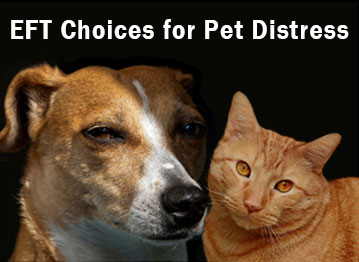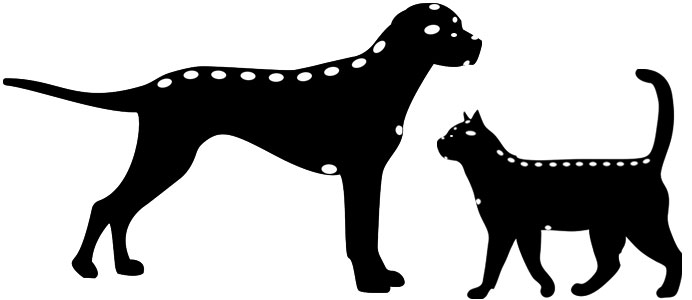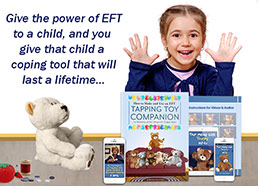 Why Use EFT for Pet Issues?
Why Use EFT for Pet Issues?
Just as humans have an innate ability to sense emotions in other humans, your pet can sense your emotions. In fact, animals are very receptive to human emotions.
An article in Newsweek reported on various research revealing how clever dogs can be at detecting human emotions, such as fear, sadness, and intention. Similarly, research on cats reveals their uncanny way of reading human expressions. These remarkable traits make pets very viable candidates for EFT (Emotional Freedom Techniques) when they are distressed. (Animal Intelligence: Dogs Understand and React to Human Emotions)
Also known as EFT Tapping or Meridian Tapping, this powerful self-help healing technique combines the principles of ancient Chinese medicine with modern psychology. Its origins lie within the development of acupuncture, a technique that uses needles on the “energy meridians.” However, EFT substitutes light “tapping” (or massaging) for acupuncture needles, which can bring about similar beneficial results in a non-threatening, non-invasive manner. Moreover, EFT couples the tapping with therapeutic phrases and affirmations to relieve emotional stress.
What are Choices and Why Do They Work?
The “EFT Choices Method” brings EFT to another level. EFT Choices work because traditional affirmations are constructed to be contrary to facts and reality. While such affirmations are useful for some people, they can be unconvincing to others, precisely because they seem so impossible.
We are all free to make a Choice about a current situation or condition. By affirming a “Choice” it won’t feel like you are “talking yourself into something.” This concept makes Choices statements believable and easy to devise. As a result, the “union” of EFT with Choices can be beneficial to both humans and animals, by opening an honest gateway of helpful interaction.
Ways to Use EFT Choices with Your Pet
- Repeat the suggested Choices aloud or silently about 8 times
- Do one round of EFT tapping on your pet, while repeating the Choice
- Surrogate EFT
Surrogate EFT is engaging in the process through:
- Proxy; tapping on yourself, or a surrogate stuffed animal
- Brain-to-brain, which is essentially telepathically
Testimonials
Hear accounts shared during a past teleseminar on using Personal Resource states by two attendees who used Choices; one tapped for a dog, the other did surrogate tapping for a cat.
Actually, the process is simple and quick. Feel free to devise similar Choices that feel comfortable for you and document them so they are readily available when you need them.

EFT TAPPING POINTS ON DOGS AND CATS
- Top of Head
- Inner Eyebrow
- Outer Eye (Or, the area between just outside the eye to just beneath the ear)
- Under Eye
- Top of Nose (This spot can be by-passed on cats, and on dogs with short snouts)
- Under Mouth
- Breast bone
- Along one side of the spine, or both sides simultaneously
- Beneath either front leg, along side of the rib cage
*** By-pass any areas that your pet doesn’t like to be touched to avoid any unnecessary aggravation or distress in the animal.
Other smaller animals, like rabbits, chickens guinea pigs, and the like can also benefit from the tapping. Although accessible tapping points are limited, the top of head and points along the spine may be viable.
The following is a derivative of content from Dr. Carrington’s no longer published book, The Secret Inner Life of Pets
How Positive Thoughts Can Help a Distressed Pet
Understandably, if your pet is distressed, you are feeling great distress and worry, whether you know the cause of the animal’s distress or the cause is unknown. It’s common for people to be obsessed with “understanding” what happened or what might likely happen. An obsessive desire to “understand” at all costs seems “hard-wired” into the human psyche.
Because your pet is so closely attuned to your moods and can catch your thoughts so readily, without realizing it, you may be wordlessly conveying your thoughts and feelings to your pet. When you begin to send positive messages to the animal, mentally and expressively, that differ from fear of negative consequences, something very wonderful can occur. Moving forward with a new, fresh, and hopeful attitude can benefit both of you. In fact, one of the greatest lessons that animals can teach us is how we can let go of the past, of negative thoughts, and imagined fears, and move forward to a happier state of mind.
I cannot emphasize strongly enough that the best way to handle your pet’s difficulty is to envision the animal as happy, healthy, and whole and not dwell on the condition, itself. Even if your pet has a limited time left to live, the greatest help you can be to him/her is to ensure your time left together is filled with positive and joyful energy at every possible moment.
EFT Choices for a Distressed Pet
The EFT Choices exercises presented here are just some strategies for troubleshooting distress in your pet when something happens, such as an illness or accident, and were designed to help you both during the difficulty.
While your pet may not fully understand human language, he/she will sense your wish to help. These Choices can help you bring about healing comfort for your pet. Your Choices can be immensely comforting to them even if their surface behavior continues to be agitated or withdrawn and even if seems to be having no effect on them. At minimum, they may bring you some inner peace and comfort.
Choice #1 – for your pet
“I choose to imagine a beautiful healing light surrounding (insert your pet’s name).”
If you can visualize a healing light surrounding your ailing pet, this can be deeply comforting. There is an old saying, “Where awareness goes, energy flows.” Since it is believed that animals tend to think in images rather than words, your pet may readily respond, telepathically, to any images or thoughts you are sending to them. It may prove to be valuable to both of you if you do this a number of times during the day.
Choice #2 – for yourself
“I choose to do things that will make me happy even if my pet is ill – and know that my good mood will benefit us both.”
As mentioned above, animals respond to a human being’s moods with amazing sensitivity. If you are upset by your animal’s condition, your distress can unfortunately make them even more upset. However, emitting a sense of calm and happiness can act as a wonderful medicine for them.
Keep repeating this Choice at various times throughout the day to remember that your happiness may assist your pet in their recovery.
Choice #3 – for your pet
“I choose to imagine that there is a healing power within the food and water I give to (insert your pet’s name here).”
If each time you give your pet water or food, you imagine that the substance contains a wonderful healing power, (and, in fact it does, because what you give your pet to ingest contains your love) your animal will sense this and may be more apt to consume it, if its body is willing.
Be mindful that any fearful or anxious messages he/she picks up from you about the animal not eating or drinking can immediately be transferred to your pet and make it less apt to comply.
Choice #4 – for yourself
“I choose to recognize the wisdom of ( ‘s insert pet’s name) body and respect its will.”
This Choice will help you harmonize with your pet’s needs, and if the illness might ultimately be leading to its passing, then it will help you begin to accept this with grace, or at least more ease.
Keep in mind that your pet may already have enough difficulty contending with his/her physical distress and does not need the additional burden of your resistance to whatever nature is directing them to do.
Choice #5 – for your pet
“I choose to imagine (insert name of your pet) in a quiet, peaceful state where he/she can hear me and feel my empathy.”
This is an important choice to make repeatedly and as many times as you like. Locate yourself close by your pet in as peaceful an environment as you can arrange. If you are at home, eliminate all distracting noises from the room, if possible, and settle down to be close to your pet, even if it is agitated or withdrawn.
You will have much more control over your environment at home, of course, than if you are visiting your pet in a veterinary hospital where there may be many distracting noises and smells bombarding it. But if that is your situation, it is even more important to convey to your pet a sense of peace and reassurance.
When Happiness Seems Impossible
If you can’t imagine how you can possibly feel happy when your pet is in so much difficulty, or if it makes you feel guilty to feel happy if they are ill, these Choices are for you to and should help you greatly.
Choice #1
“I choose to remember how (insert your pet’s name) and I did (insert a short description of something fun you did together).”
Choice #2
“I choose to remember how helpful it was to have (insert name of your pet) with me when (describe a distressing situation where his/her presence at the time was very helpful to you).”
Choice #3
“I choose to remember how wonderfully comforting it was to have (insert name of pet) with me when (insert an incident when you really appreciated having him/her there) happened.”
Or choose the memory of any other outstanding moment that you had with your pet – there are probably many of them so you may have many possibilities. Focus on that good, happy feeling, only.
Handling Guilt Over a Pet
If you are experiencing guilt about real or imagined things you did or didn’t do that you believe were harmful to, or contributed harming your animal, heed the following advice.
Know that animals don’t “dwell” on what went wrong, for the animal it simply dissolves.
If you are ruminating on and visualizing a tragic event involving your pet over and over again, that animal will pick up on everything you’re thinking. Pets know if the thoughts in their beloved human(s) are about them and therefore they know when the humans they love feel horrible. This means that the message they are getting is, “My human thinks about me and feels horrible!”
In their simplistic world, pets put those two things together and can arrive at the conclusion: “I’m making my person feel horrible.” Rather than dwell on those painful thoughts of self-recrimination you can help your pet far more by understanding how your loved animal actually wants you to be joyful and to live fully in each moment.
Realize that the animal can’t understand why you would want to worry about the past. It also can’t understand why you would want to worry about the future. Animals don’t recognize, or in any way understand, our human feelings about worrying, the passage of time, or the importance of times, other than their “present.” Those are actually a meaningless concepts to them.
With that said, here are some Choices to do for yourself that can help you if you feel guilty about anything you may have done (or failed to do) that you fear has harmed your pet:
Choice #1
“I choose to let go of my obsession with what is “right” or “wrong” in this instance, and know that there is no such thing as “right” or “wrong” in my pet’s way of thinking.”
This Choice honors the totally nonjudgmental nature of animals. There are certain things that concern every animal; food, shelter, warmth, and whether or not it is experiencing love. But animals have no concerns derived from judging, and for this reason there is no blame involved for anything you may have done or failed to do with respect to them. You can consider the situation as a slate wiped clean and replace your worry with good cheer and love for your pet and you’ll be on exactly their wavelength and doing a great favor to your pet.
The following Choice may help with this:
Choice #2
“I choose to recognize that I am being given a wonderful chance to experience a positive, and deeply loving relationship with my pet right at this moment, .”
This Choice offers an opportunity to express great love for your pet by wiping away the need to dwell upon any difficulty between you. You will be eliminating any pain, guilt, or remorse in yourself. Whatever either you or your pet did as part of creating the difficult circumstance you find yourself in, it can to be wiped clean – gone!
Choice #3
“I choose to learn how I should act toward myself, or others involved in this unfortunate incident, from my pet’s natural and complete nonjudgmental attitude.”
Choice #4
“I choose to let (insert your pet’s name) be my role model and learn from him/her the power of forgiveness.”
I can’t emphasize often enough that if you do this periodically during the day, and for a number of days, something good will happen that is of a healing nature.
Pets are Amazing Role Models
Of central importance is to remember the life lessons our pets teach us wordlessly, through their example. They can be superb role models for us and the more conscious of this fact that we are, the more value we can derive from them.
Here is a list of just some of the valuable qualities our pets can embody for us:
- Love without judgment or conditions, an innocent unconditional love. Judgment of others is simply not possible for an animal, it is not in their “vocabulary.”They are here for us and they don’t care if we’re a criminal or a nun. They don’t care if we’re employed or not. They don’t care. It simply doesn’t matter to them.
- Unquestioned forgiveness
- Complete authenticity, no deceptions are possible for an animal; they can teach us how to be more authentic
- Total joy in living, many times a day, over and over
- Being able to live in the present. Our pets love and thrive on being in the moment. They teach us that “right now” is what it is all about. Right now, here in this moment, loving life, enjoying a sunspot or curling up in their favorite “place” to sleep, enjoying running through a field or chewing on a bone – whatever it is they are doing is what they thrive on. They are enjoying the moment. All the other “nonsense” that humans conjure up, outside of being in the moment, is incomprehensible to them.
- The impulse to help others no matter what it takes to do it – to instantly “be there” for them.
Whatever the problem, we can give our greatest help to our pets by expressing our empathy and love, verbally, mentally, or by some simple caring act, as often as possible.
Wishing you and your beloved pet(s) all the best….






Thank you very much ! <3
You’re most welcome, Peggy 🙂
Thank you for sharing the testimonial audio. Hearing Dr. Carrington’s voice once again was very moving. Such a beautiful woman.